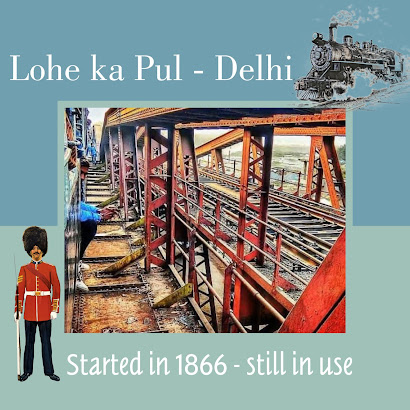When I was a little boy, My father used to take me to the legendary Iron Bridge or Lohe Ka Pul at Lal Qila to reach the other end of Delhi. We used to visit some of our relatives in Shahdara area and at that time that was the only Bridge that used to connect New Delhi with Yamuna Paar Delhi.
At that time I used to remember that the trains used the upper section of the Bridge and normal traffic used the middle segment. It used to be very congested and polluted but that was the only way back than.
But never I realised that this Iron Bridge or popularly known as Lohe Ka Pull has a history associated with it.
Lohe Ka Pul or the legendary Iron Bridge on the Yamuna dates back to 1863 -1866, a 12 spanned wonder of its time whose construction began just after the year the Last Mughal Emperor Bahadur Shah zafar’s death. He opposed the very idea of this bridge that would bring trains in Red Fort. Earlier meant for a single line but was converted into a double line in 1913 by the Northern Railways.
Like that there are many bridges in Delhi but none like Loha-ka-pul. The one over the Red Fort moat was constructed in the reign of Akbar Shah Sani to replace an earlier draw-bridge to facilitate entry into the Lahori Gate. The work was entrusted to Robert Macpherson, who was honoured by the Mughal emperor with the title of Dilawar-ud-daulah Deler Jung in 1811. The Mansi bridge connecting the fort to Salimgarh replaced the bridge built by Jahangir. The Athpula dates back to Akbar’s time. The Barapula, south of Nizamuddin station too came up in Jahangir’s reign in 1611-12. Now it has been renamed by the Delhi Govt as Banda Bahadur bridge in honour of the Sikh warrior of Farruksyer’s time. The bridge near Siri Fort is of the 14th Century Khilji times, while the Satpula, east of Khirki village, dates back to Mohammed Tughlaq’s reign.
In the Walled City the Lothian bridge was constructed by Lt-Col Sir Lothian Kerr Scott (1861-67). About 300 yards from it is Kauria bridge, linking Old Delhi station to the Kashmere Gate area, opposite the GPO. This bridge had replaced an earlier one built of cowrie shells (hence the name) collected as “tehbazari” or tax by an 18th Century nobleman, Shad Khan in the reign of Shah Alam. The Minto bridge of the Northern Railway near Connaught Place came up in 1933. The bridge on Kamal Ataturk Road was built in the same year. The Kotla Mubarakpur bridge also came up in the 1930s. The Wazirabad bridge, near Majnu-ka-Tila was built in the time of Ferozeshah Tughlaq and has been in use for over six centuries now.
The East India Company spent Rs 14 lakh in 1866 which was a huge amount in those days. It was named Bridge No 249 at that time in the Railway Records. This Bridge helped to connect Lahore to Delhi and Delhi to Kolkatta.
This bridge withstood many floods of Delhi especially in 1978 when entire northern Delhi Submerged in water. During floods it was always a custom to stop both the rail and road traffic on this bridge. You would be surprised to know that linesmen of the railways used to carry an iron ball tied with a long rope. They used to hit that iron ball on the pillars of the bridge submerged in water just to see if there is sand near the concrete walls of the bridge. This routine was established in 1870s and was still used.
Though many Ghost stories has been associated with this Jamuna Bridge but people love this as an heritage of their glorious past. Some people say they have seen ghosts on these tracks – some day they seen angel like energies during night patrols but one thing is sure that this Bridge is serving Delhi for more than 154 years and you never know till when –




Comments
Post a Comment